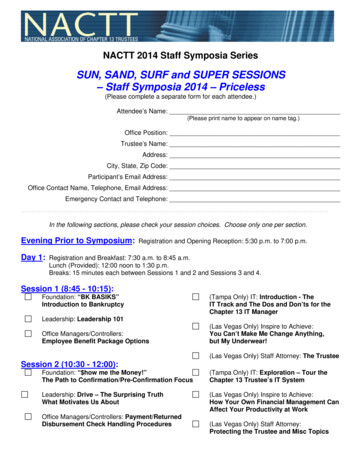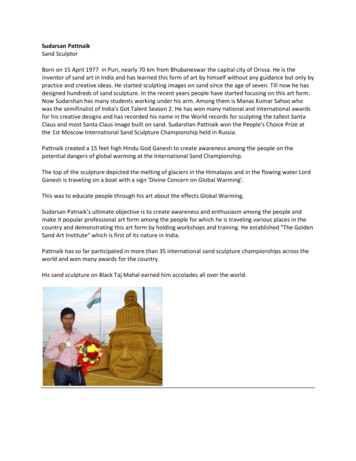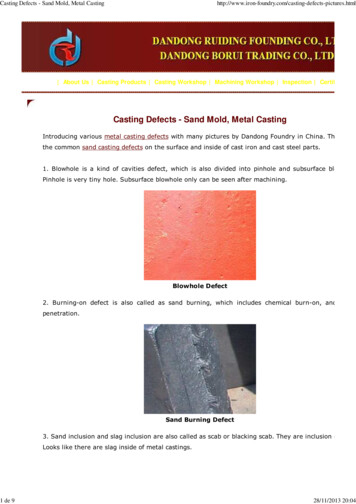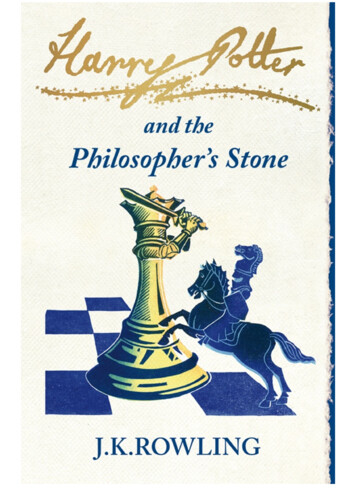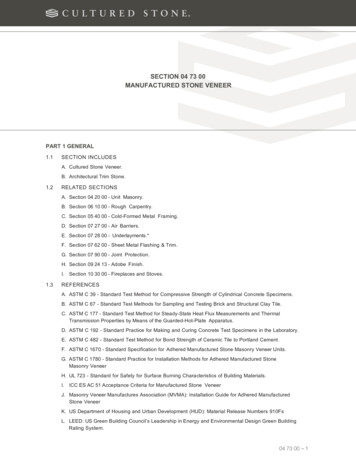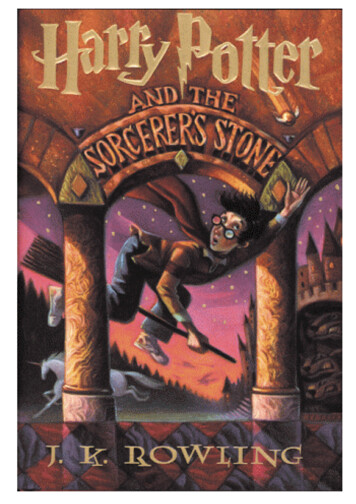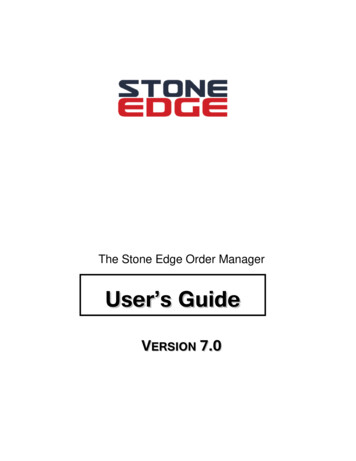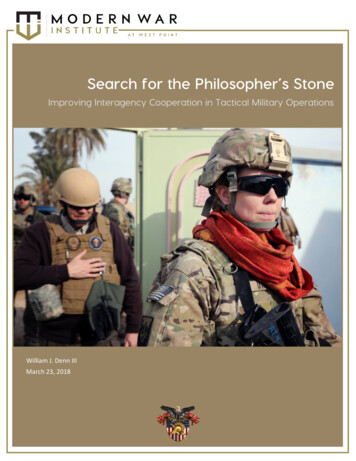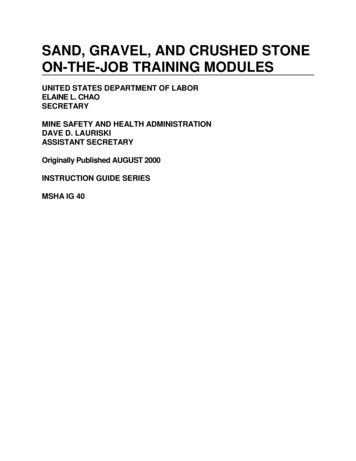
Transcription
SAND, GRAVEL, AND CRUSHED STONEON-THE-JOB TRAINING MODULESUNITED STATES DEPARTMENT OF LABORELAINE L. CHAOSECRETARYMINE SAFETY AND HEALTH ADMINISTRATIONDAVE D. LAURISKIASSISTANT SECRETARYOriginally Published AUGUST 2000INSTRUCTION GUIDE SERIESMSHA IG 40
These training modules were developed cooperatively by MSHA and members of the sand,gravel, and crushed stone industry. We gratefully acknowledge the valuable contributionsof Gifford-Hill and Company, Inc., National Gypsum Company, National Stone Association,The Spline Education Center, Martin-Marrietta Corp., W. W. Boxley Co.,and others, to thisInstruction Guide.Copies of this Instruction Guide, and others in this series, may be ordered by calling, orwriting:National Mine Health and Safety AcademyOffice of the Business Manager1301 Airport RoadBeaver, WV 25813Phone: (304) 256-3257or by contacting your local MSHA office.This Instruction Guide is designed to supplement existing health and safety trainingprograms. The material is not intended to cover all specific jobs at any given operation.Other modules may be added, and existing modules revised, in future printings of thisInstruction Guide.Individual modules in this Instruction Guide are designed to be used separately. Themodules can be kept together in a three ring binder when not in use. General informationand training recommendations are included at the end of each module.DISCLAIMERThe information and recommendations contained in this publication have been compiledfrom sources believed to be reliable, and to represent the best current opinion on thesubject matter. No warranty, guarantee, or representation is made by MSHA as to theabsolute correctness or sufficiency of any representation contained in this publication, andMSHA assumes no responsibility in connection therewith. Nor can it be assumed that allacceptable safety measures are contained in this publication, or that other, or additional,measures may not be required under particular, or exceptional circumstances.
TABLE OF CONTENTSMODULE 1 STARTING THE PLANTMODULE 2 PLANT CLEAN-UPMODULE 3 PLANT SHUTDOWNMODULE 4 PLANT OPERATIONMODULE 5 MAINTAINING CONVEYOR SYSTEMSMODULE 6 PLANT REPAIRMODULE 7 WELDING AND CUTTINGMODULE 8 EQUIPMENT LOCK-OUT PROCEDURESMODULE 9 ELECTRICAL PROCEDURES FOR NON-ELECTRICIANSMODULE 10 TRUCK HAULAGEMODULE 11 GROUND CONTROLMODULE 12 INSPECTING AND REPLACING CABLES (WIRE ROPES)MODULE 13 REPLACING THE DRIVE CHAIN OR BELT ON A SCREW CONVEYORMODULE 14 MANUAL HANDLING OF MATERIALSMODULE 15 USING AN OVERHEAD HOIST TO LIFT OR HANDLE PARTS OR MATERIALSMODULE 16 HANDLING MATERIAL WITH A SHOP OVERHEAD TRAVELING CRANEMODULE 17 PRIMARY CRUSHING OPERATIONMODULE 18 OPERATING DRILLING EQUIPMENTMODULE 19 TRANSPORTATION, USE, AND STORAGE OF EXPLOSIVES
MODULE NUMBER 1OFINSTRUCTION GUIDE NUMBER 40ON-THE-JOB TRAINING MODULESFOR THESAND, GRAVEL, AND CRUSHED STONESTARTING THE PLANTThis module describes basic job steps, potential hazards and accidents, and recommendedsafe job procedures for plant start-up.This job is usually done by the plant operator, but may be done by other occupations, suchas utility worker, laborer, etc.The plant operator/utility worker must make sure thatemployees, and others, are protected from accidents and injuries resulting from plant start-up.While both sand and gravel plants, and crushed stone plants, are built by many differentmanufacturers, the processes and equipment involved in the production effort are similar.iv
SAND AND GRAVEL PLANTSAt a typical sand and gravel plant, raw material from a hopper at a dumping station is carriedby a conveyor belt to a screening deck. The screening deck removes oversized material(large clay balls, roots, very large rocks, etc.), separates sand from gravel, and then separatesthe gravel into different sizes. Spray bars wash the gravel as it passes through the screeningdeck.Large stones then go to log washers, while medium size material (chat and/or pea gravel) iscarried to a screw. The large stone, after emerging from the log washer, and the finermaterial, after emerging from the screw, pass through separate final rinse stations on the wayto storage areas. Transportation to a storage area may be by a fixed conveyor system, aradial stacker system, or an extendable belt conveyor system. A radial stacker is a conveyorsystem that rotates from a fixed pivot point, and stores the conveyed material in an arcshaped stockpile. The extendable belt conveyor system has the capability of lengthening orshortening itself by moving the head section. The head section is mounted on wheels, andmoves on rails, which allows the conveyor to supply several stockpiles, hoppers, or silos.Sand, after being separated on a screening deck, flows to a classifier, where it is washed andsized. The sand is then carried by a screw, which separates the sand from the water, to aconveyor belt, which carries it to a storage area.Water that is used in the plant is pumped from a freshwater pond. The discharged water isthen pumped into a settling pond.A crushed stone plant differs somewhat from a sand and gravel plant. Raw material isbrought from a quarry to a primary crusher by rear dump haul trucks. Some primary crushersare fed by wobblers, which are chain driven conveying systems with eccentric rollers.After primary crushing, material is conveyed by belt to a scrubber for washing. The scrubberis a cylindrical, rotary device with internal screens and auger type vanes that carry thematerial through the scrubber. Fine material is separated from the coarse material in thescrubber. The fine material is sent to a settling pond. The coarse material is sent to a surgepile, and then to a primary screening deck. Oversized material is carried from the primaryscreening deck to secondary crushers, and is then returned to the primary screening deck tobe separated into desired products. A crushed stone plant contains a series of screeningdecks, crushers, and final rinse screening stations. Finished product travels through a finalrinse stage, and is then stored in silos, bins, or stockpiles.A sand and gravel, or crushed stone, plant consists of a number of interdependent productionprocesses. Therefore, it is important to know how the plant operates in order to prevent amassive pile-up of material at a transfer point during plant start-up.An improper start-up sequence can damage plant equipment, and also increase the risk ofinjury. Fresh-water, sand, and other pumps are started first. Other plant equipment must bev
started in reverse order of material flow, beginning with the finished product conveyor, andworking back through the primary hopper feeder belt.In addition to following the proper start-up sequence, the person starting the plant must takeevery precaution to ensure that other people are clear of equipment before the equipment isstarted.vi
The following safe job procedures will help to minimize incidents that may cause injuries, andadversely affect production.REQUIRED, OR RECOMMENDED, PERSONAL PROTECTIVE EQUIPMENT:HARD HAT, STEEL-TOED SHOES, LIFE JACKET, GOGGLESSEQUENCE OFBASIC JOB STEPSPOTENTIAL ACCIDENTSOR HAZARDS1. Start primarypump.1. A) Falling into water.2. Start allconveyors,shakers, andassociatedequipment instart-upsequence.RECOMMENDED SAFE JOBPROCEDURES1. A) Wear life jacket.B) Slipping/falling onplatform.B) Use designated walkways,and examine forslipping/tripping hazards.C) Electrocutionhazards.C) Examine work area forexposed wires, frayedinsulation, etc.D) Mechanicalhazards.D) Examine work area formissing guards, exposedmoving machine parts,etc. Sound warning horn,if applicable.2. A) Personnel caught inconveyors andother equipment.2. A) Check that all movingparts have guards inplace. Make sure allpersonnel are clear ofequipment. Sound alarm.B) Spillage at transferpoints.B) Proper start-up sequencebegins with finishedproduct belts, andcontinues to primaryfeeder.C) Short circuit inswitch box.C) Stand to the side of switchbox, in case door blowsopen when activated.vii
SEQUENCE OFBASIC JOB STEPSPOTENTIAL ACCIDENTSOR HAZARDSD) Problems withequipment at startup, such as electricmotor fires, beltslippage, etc.3. Inspect theoperating plant forproblems andhazards.RECOMMENDED SAFE JOBPROCEDURESD) Check piece of equipmentafter starting, beforestarting something else.3. A) Getting caught inmoving parts.3. A) Check that all guards arein place. Cross belts onlyat designated crossovers.Do not extend any part ofbody beyond edge of belt.B) Tripping hazards.B) Walkways should be keptclear of trash, tools, etc.Check for loose or missinghandrails, walkwaygrating, or toeboards.C) Burns.C) Check for overheatedgearboxes (listen forgrinding sound). Check ifgearbox is loose on mainshaft. Visually checkbearings through guardwhile running. Look fororange color on shaft, orshaft wobbling.D) Electrical hazards.D) Check for obviouselectrical hazards, such asexposed wires, missingjunction box covers,frayed insulation, missinglight bulb guards, etc.viii
GENERAL INFORMATIONThis module is part of an Instruction Guide that was developed to assist the sand, gravel, andcrushed stone industry in conducting effective on-the-job training (OJT) of new employees,or employees reassigned to different jobs. The use of training materials, such as this module,is an important part of an effective, systematic, OJT program.This Instruction Guide uses a generic Job Safety Analysis (JSA) of jobs common to theindustry. The JSA format facilitates uniform basic training in safe job procedures, whilerequiring only a minimum of time and effort on the part of the trainer. This material is genericto the industry; therefore, each company using this guide will need to tailor the materialsomewhat to fit their particular requirements. In some cases, the material must be generalin nature, and will not include specific details of procedures or equipment that must be taughtby the trainer.Recommendations for an overall OJT program are contained in the Mine Safety and HealthAdministration (MSHA) guide: “Structuring Effective On-The-Job Training Programs,” June,1983.TRAINING RECOMMENDATIONSOn-the-job training is usually best done by the employee’s immediate supervisor. If thesupervisor relies on another employee to do certain parts of the training, the supervisorshould be present to monitor the training. OJT is conducted at the actual job site where thework will be done.The supervisor/trainer should use the training materials (this module, or other materials) whilethe training is being done, to help ensure that all job steps are covered, and that no importantsafety precautions are omitted. Effective OJT should begin with an explanation (lectureand/or discussion) of the safe job procedure. The explanation should be followed by a handson demonstration of the proper job procedure. A good demonstration is, perhaps, the mostimportant part of OJT. The demonstration is followed by supervised practice, during whichthe supervisor/trainer coaches (corrects and encourages) the employee, and evaluates whenthe employee is ready to do the job without direct supervision.The first step - explaining the job to the employee - can be done in different ways. Thesupervisor/trainer and the employee can sit down and go through the training materialstogether. It may be advantageous to provide the employee with a copy of the trainingmodules that are applicable to his/her job. The fact that most of the training is conducted atthe job site does not preclude the use of a classroom, or a quiet office, for the first part of thetraining. Any general theory, or knowledge training, as well as the initial explanation of thejob procedure, may be best done in an office/classroom setting, especially when noise levels,or other conditions at the job site, make communication difficult. A complete series of jobsteps could be presented through the use of slides developed at the mining operation.ix
MODULE NUMBER 2OFINSTRUCTION GUIDE NUMBER 40ON-THE-JOB TRAININGFOR THESAND, GRAVEL, AND CRUSHED STONE INDUSTRYPLANT CLEAN-UPFor the job of plant clean-up, this module describes the basic job steps, potential accidentsand hazards, and recommended safe job procedures.A tremendous quantity of material passes through a typical plant every day. Obviously, anobjective is to deliver all the material to its final destination. However, because of thecharacteristics of the material - variable nature, extremely abrasive, often coated withcohesive material - some spillage will occur, which may necessitate frequent clean-upactivities.Belt conveyors are a major source of spillage. Spillage usually can be found at return idlers,tail pulleys, take-up pulleys, and transfer points. Chutes and skirt boards, that are used attransfer points, are subject to corrosion and wear from wet and abrasive materials. Holes willeventually form in chutes and skirt boards, resulting in spillage at transfer points.x
A considerable amount of fine material is present in unwashed material coming from thefeeder hopper to the main feeder belt. This unwashed material is usually coated with clay,and tends to stick to the belt. Return idlers, tail pulleys, and take-up pulleys pick up this claycovered material, and sling it onto surrounding surfaces. Chute boxes (skirt boards) may notcatch all of the material, thereby allowing it to accumulate at the tail pulley. Belts, other thanthe main feeder belt, are subject to smaller amounts of spillage and accumulated finematerial.Spillage can also occur around scrubbers, crushers, shaker decks, classifier stations, andfinal rinse screening stations. Spillage in these areas can be caused by worn chutes,excessively wet material, or excessively high material feed rate. Material can bounce or rolloff shaker screens, especially when the screens become clogged with flat rocks or clay.Loose or broken connections at classifier dumping stations, just above splitting troughs, cancause considerable amounts of spillage.Spillage
HARD HAT, STEEL-TOED SHOES, LIFE JACKET, GOGGLES SEQUENCE OF POTENTIAL ACCIDENTS BASIC JOB STEPS OR HAZARDS 1. Start primary 1. A) Falling into water. pump. B) Slipping/falling on platform. C) Electrocution hazards. D) Mechanical hazards. 2. Start all 2. A) Personnel caught in conveyors, conveyors and shakers, and other equipment. associated

